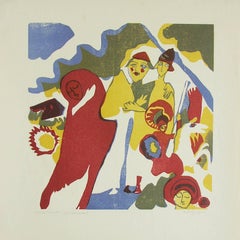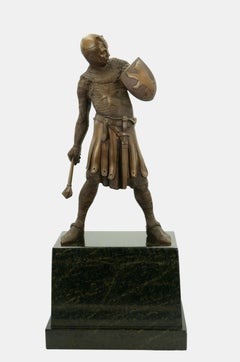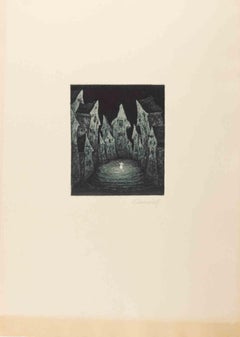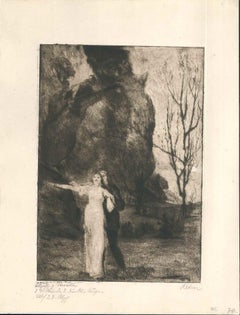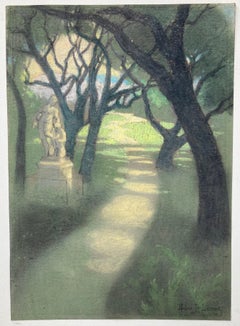1910s Art
to
269
1,083
355
394
190
169
Overall Width
to
Overall Height
to
7,541
21,279
158,949
232,530
1,968
2,243
4,927
6,410
5,815
13,295
19,728
25,675
18,296
13,577
5,382
410
312
138
137
47
20
19
12
6
1
1,225
883
32
1,425
690
592
408
385
351
215
151
144
137
132
121
114
100
96
91
76
76
59
57
864
627
485
394
385
95
51
34
23
22
849
362
1,169
949
Period: 1910s
Allerheiligen- All Saints Day.
Located in New York, NY
KANDINSKY, Wassily. Allerheiligen- All Saints Day. Original three-color woodcut (red, yellow ochre, blue – with olive green). 1911. Signed with the monogram...
Category
Blue Rider 1910s Art
Materials
Woodcut
Crusader with shield and mace / - Ready to strike -
Located in Berlin, DE
Josef Moest (1873 Cologne - 1914 Rath), Crusader with shield and mace, around 1910. Bronze on a black marble pedestal (19 cm high). 57.5 cm (total height) x 21 cm (width) x 12 cm (de...
Category
Realist 1910s Art
Materials
Bronze
Fieber - Etching by Fritz Schwimbeck - 1918
Located in Roma, IT
Etching realized by Fritz Schwimbeck in 1918.
Edition of 125 realized in Munich on mulberry paper.
Hand signed in pencil.
Category
Symbolist 1910s Art
Materials
Etching
Etching 1916 Number II
Located in New York, NY
Wassily Kandinsky (1866-1944), Etching 1916 Number II, drypoint, signed in pencil lower right, titled, numbered (No. 9) and dated lower left [also with initials and date in the plate lower right]. Reference: Roethel 154, only state, edition of 10. In excellent condition (the barest handling fold at sheet edge), printed on a heavy ivory wove paper, the full sheet with full margins, 4 7/8 x 3 1/4, the sheet 17 1/2 x 13 inches, archival mount with window mat.
A fine fresh impression of this great rarity, printed in a dark brown ink.
Kandinsky created this drypoint (erroneously named Etching 1916) in early 1916 while staying with Gabriel Munter in Stockholm during the winter of 1915-16. This is from the second series of drypoints he made; the first was in the year 1913-14.
Provenance: Kornfeld Auction, Bern, June 2007.
The tiny size of this edition (10) makes this print a great rarity within the Kandinsky’s printed...
Category
Abstract 1910s Art
Materials
Drypoint
Mein Weg mit dem Weib #14 - Original Etching by W.R. Rehn
Located in Roma, IT
Drypoint and aquatint (brown ink) on cream paper.
Signed "Rehn" in pencil on the lower right margin. Titled and numbered in pencil on the lower left margin. Edition of 25 prints. Fr...
Category
Symbolist 1910s Art
Materials
Drypoint, Aquatint
FOOTBALL STATUE THROUGH THE TREES - UC BERKELEY 1921 ORIGINAL YEARBOOK PASTEL
Located in Santa Monica, CA
PEDRO J. LEMOS (American, 1882-1954)
FOOTBALL STATUE THROUGH THE TREES - UC BERKELEY 1921 - THE ORIGINAL YEARBOOK PASTEL
Pastel drawing on colored paper 12 5/8 x 9 5/8 inches. Full signature in pastel, Pedro J Lemos. In good condition. A few bits of old tape at the corners, verso. THE 1921 UC BERKELEY YEARBOOK CONTAINED SEVERAL LEMOS PASTEL REPRODUCTIONS.
Pedro de Lemos was an important proponent of the Arts and Crafts Movement. He produced some of the finest color woodcuts of the period as well as fine pastels, paintings and architecture.
He was also an instructor and director of the Stanford University Art Department,
From Wikipedia:
Pedro Joseph de Lemos (25 May 1882 – 5 December 1954) was an American painter, printmaker, architect, illustrator, writer, lecturer, museum director and art educator in the San Francisco Bay Area. Prior to about 1930 he used the simpler name Pedro Lemos or Pedro J. Lemos; between 1931 and 1933 he changed the family name to de Lemos, believing that he was related to the Count de Lemos (1576–1622), patron of Miguel de Cervantes. Much of his work was influenced by traditional Japanese woodblock printing and the Arts and Crafts Movement. He became prominent in the field of art education, and he designed several unusual buildings in Palo Alto and Carmel-by-the-Sea, California.....
In 1911 he began teaching decorative design at the San Francisco Institute of Art.[8] In late 1912 he was one of the founders the California Society of Etchers, and the following year he started offering the Institute's first classes in printmaking. Some of his students, such as William S. Rice and John W. Winkler (1894-1979), went on to achieve significant fame as printmakers. He helped organize the California print...
Category
Tonalist 1910s Art
Materials
Pastel
Original Your Country Needs You! Join the Navy Now! vintage WW1 poster
Located in Spokane, WA
Original WW1 poster: "Your Country Needs You! Join the Navy Now!"
Original poster printed by the U.S. Food Administration during World War One. Archi...
Category
American Realist 1910s Art
Materials
Lithograph
$1,000 Sale Price
20% Off
Sundown - Sandvig - 1918 - Realist Landscape Oil Painting by Peder Mork Monsted
Located in Marlow, Buckinghamshire
Signed, titled and dated oil on canvas landscape by Danish realist painter Peder Mork Monsted. This stunning piece depicts a beautiful view of the Sandvig Stand, the beach and coastl...
Category
Realist 1910s Art
Materials
Oil, Canvas
Summer Days Impressionist
Located in New York, NY
Edward Dufner is one of America's finest American Impressionists. This is an exceptional work by him. The technique is exquisite with the brushwork being refined and sophisticated,...
Category
American Impressionist 1910s Art
Materials
Watercolor, Gouache
Portrait of a notable with a mustache
Located in Genève, GE
Work on canvas
Category
1910s Art
Materials
Oil
"Stone Wharf, Brittany" Jane Peterson, American Impressionist, Boats in Canal
Located in New York, NY
Jane Peterson
Stone Wharf, Brittany, circa 1910
Signed lower right
Oil on canvas
18 x 24 inches
Provenance
Private Collection, New York
Born Jennie Christine in Elgin, Illinois, s...
Category
American Impressionist 1910s Art
Materials
Canvas, Oil
Woman on a Patio
Located in Fairlawn, OH
Woman on a Patio
Pastel on paper, c. 1915
Unsigned
Provenance: Gift of the artist to his wife, Mary Hess Buehr
By decent to the artist's niece, daughter of Will...
Category
Abstract Impressionist 1910s Art
Materials
Pastel
"What Will Your Answer Be" What did YOU do to help. original vintage poster
Located in Spokane, WA
Original, WHAT WILL YOUR ANSWER BE when your boy asks you -- "Father, - what did you do to help when Britain fought for freedom in 1916?" horizontal, linen-backed, excellent condition ENLIST NOW.
Poster showing, in silhouette, a boy in scout uniform addressing his father. This poster was also printed with the same text but using "Ireland" in the text. Iconic British World War 1...
Category
American Impressionist 1910s Art
Materials
Lithograph
$1,000 Sale Price
20% Off
1918 original poster "Break your sugar in half today to have some tomorrow"
Located in PARIS, FR
This 1918 original poster, designed by Yvonne Colas, is a compelling piece of World War I propaganda, urging civilians to ration sugar to ensure future supplies. Created during a tim...
Category
1910s Art
Materials
Paper, Lithograph
Mädchen mit grünem Rock - Original Lithograph After E. Schiele
Located in Roma, IT
This lithograph from the portfolio "Egon Schiele" is a reproduction of "Mädchen mit grünem Rock", an original artwork realized by Egon Schiele in 1910.
The portfolio, that includes...
Category
Modern 1910s Art
Materials
Lithograph
Orignal Ville de Bruxelles City of Brussels vintage poster 1914
Located in Spokane, WA
Original Ville de Bruxelles (City of Brussels, Belgium) vintage art nouveau poster. This beautiful lithograph is in excellent condition, ...
Category
Art Nouveau 1910s Art
Materials
Lithograph
$2,360 Sale Price
20% Off
Circa 1915 French wartime propaganda original poster of World War I
Located in PARIS, FR
This circa 1915 French wartime propaganda poster is a striking example of World War I-era rationing efforts, emphasizing collective sacrifice and equitable distribution. Designed under the direction of the Comité de Prévoyance et d’Économies, this poster encouraged the French population to ration essential goods, particularly sugar, during the war.
At the heart of the artwork is a symbolic sugar loaf, partially cut by a saber, visually reinforcing the message of dividing resources fairly. The text reads:
"Avec la carte, nous en aurons peu – mais nous en aurons tous."
("With the ration card, we will have little – but we will all have some.")
This message aimed to instill a sense of national solidarity and compliance with rationing policies. The lower inscription, "Casse aujourd’hui ton sucre en deux pour en avoir demain?" ("Break your sugar in half today to have some tomorrow?"), serves as a direct appeal to personal responsibility in wartime resource management.
The bold yet simple color scheme (blue, red, black, and beige) gives the poster a striking visual identity, making it both an effective propaganda piece and a historically significant artifact.
This rare wartime poster is a powerful reminder of civilian resilience and the role of public cooperation in wartime economies. Due to its historical importance and striking design, it remains highly collectible, particularly among WWI memorabilia...
Category
1910s Art
Materials
Linen, Paper, Lithograph
Pablo Picasso, L'Abreuvoir from La Suite Saltimbanques
Located in Chatsworth, CA
This piece is an original drypoint created by Pablo Picasso in 1905 and printed by Ambroise Vollard after steel-facing in 1913. It is from a series entitled La Suite des Saltimbanque...
Category
Surrealist 1910s Art
Materials
Drypoint
R. Layni, Zeichnungen folio, "Seated Woman with Bent Knee" Collotype plate I
Located in Palm Beach, FL
After Egon Schiele (1890 – 1918), AUSTRIA
“ART CANNOT BE MODERN, ART IS PRIMORDIALLY ETERNAL.” -SCHIELE
Defiantly iconoclastic in life and art, Egon Schiele is esteemed for his mas...
Category
Vienna Secession 1910s Art
Materials
Paper
Early 20th Century St. Mark's Basilica Landscape
Located in Soquel, CA
Beautiful early 20th century impressionist painting of St. Mark's Basilica, by an unknown artist (American, 20th Century), 19...
Category
Impressionist 1910s Art
Materials
Canvas, Oil
$956 Sale Price
20% Off
Autumn Landscape
By Royal Milleson
Located in Fairlawn, OH
Autumn Landscape
Oil on relined canvas, c. 1915
Signed lower right corner: "Royal H. Milleson"
Condition: Excellent
Canvas size: 14 1/2 x 20 3/8 inches
Frame size: 19-1/4 x 25-1/4 x 2-1/2 inches
Clearly among the artist's finest paintings!
Provenance: Private Collection, Greencastle, Indiana
Ray H. French Collection (1919-2000)
Martha A. French Trust
Royal Hill Milleson...
Category
American Impressionist 1910s Art
Materials
Oil
Female Warrior
Located in New York, NY
A very unique bronze that touches upon the classic, female strength in form and the details beaux arts style in America. A work that really is for a collector and to be put in a spo...
Category
American Modern 1910s Art
Materials
Bronze
Elmo the Mighty, the great Elmo Lincoln original lobby cartd
Located in Spokane, WA
ELMO THE MIGHTY, original 1919 lobby card, not signed. Protected in a 16" x 20" acid-free presentation mat suitable for framing. This lobby card is over 100 years old.
Original,...
Category
American Realist 1910s Art
Materials
Offset
$300 Sale Price
20% Off
Bayros-Mappe III - Héliogravure by Fraz von Bayros - 1913
Located in Roma, IT
Héliogravure on japanese paper realized by Fraz von Bayros in 1913 for Ex Libris Verlag K. Th. Senger, Munich.
Mounted on passepartout. Edition of 260, hand signed in pencil by the ...
Category
Symbolist 1910s Art
Materials
Photogravure
Portrait of a Lady in Pince Nez - British 1919 art portrait oil painting
By Alfred Kingsley Lawrence
Located in Hagley, England
This superb British portrait oil painting is by noted artist Alfred Kinglsey Lawrence. Painted in 1919 it is a seated portrait of a young woman with a lush burgundy velvet curtain be...
Category
Realist 1910s Art
Materials
Oil
Circa 1910 original advertising poster promotes the H. Vigneron sewing machines
Located in PARIS, FR
This circa 1910 original advertising poster promotes the H. Vigneron sewing machines, a brand sold at 70, Boulevard de Sébastopol, Paris. Designed in a distinctive early 20th-century...
Category
1910s Art
Materials
Linen, Paper, Lithograph
Original Wallpapers and Decorations John Gilkes & Sons vintage poster
Located in Spokane, WA
Wallpapers and Decorations John Gilkes & Sons. Original stone lithograph. Size: 31" x 47". C. 1915 - 1920. Printer: J.J. Keliher & Co., London Archival linen backed authentic antique poster...
Category
Art Nouveau 1910s Art
Materials
Lithograph
Art Deco Watercolor 1918, By Otto Lendecke Decorated Salon Helena Rubinstein
Located in Eltville am Rhein, DE
Otto Friedrich Carl Lendecke
Lemberg 1886 - 1918 Vienna
Ich werde beobachtet!
I am being watched!, 1918
Watercolor and pencil on paper / cardboard
Signed and dated lower left, tit...
Category
Art Deco 1910s Art
Materials
Watercolor
Reclining Man Ashcan Early 20th Century American Scene Social Realism Gay Nude
By Isidore Konti
Located in New York, NY
"Reclining Man" Ashcan Early 20th Century American Scene Social Realism Gay Nude
Isadore Konti (1862 - 1938)
"Reclining Man"
7 1/2 w x 4 1/2 d x 7 high inch...
Category
American Realist 1910s Art
Materials
Bronze
Geneva countryside
Located in Genève, GE
Work on canvas
Category
1910s Art
Materials
Oil
Figures on a Woodland Path - British Edwardian art landscape oil painting
Located in Hagley, England
This charming British Edwardian oil painting is attributed to the circle of Tom Mostyn. Painted circa 1910 it is a wooded landscape with figures stopping to rest on a path bathed in ...
Category
Impressionist 1910s Art
Materials
Oil
$4,799 Sale Price
20% Off
Verlassene Muhle - Etching by Fritz Schwimbeck - 1918
Located in Roma, IT
Etching realized by Fritz Schwimbeck in 1918.
Edition of 125 realized in Munich on mulberry paper.
Hand signed in pencil.
Category
Symbolist 1910s Art
Materials
Etching
“Roses and Pansies”
Located in Southampton, NY
Very well executed watercolor and gouache on heavy card stock of a spring bouquet composed of mainly roses and pansies. Unsigned. Circa 1915. Original gold painted wood frame. Under...
Category
Post-Impressionist 1910s Art
Materials
Watercolor, Gouache, Cardboard
$300 Sale Price
20% Off
Antique American Impressionist Parrot Portrait Interior Scene Framed Painting
Located in Buffalo, NY
Impressive early American impressionist parrot portrait oil painting. Framed. Oil on board. Image size, 20H by 16L.
Category
Impressionist 1910s Art
Materials
Canvas, Oil
$1,980 Sale Price
20% Off
1917 original poster by Albert Besnard - 3e emprunt de la défense nationale
Located in PARIS, FR
This 1917 original wartime propaganda poster, designed by Albert Besnard, was created to promote the Third National Defense Loan (3e Emprunt de la Défense Nationale) in France during World War I. As the war raged on, France needed financial support from its citizens to sustain military efforts, and posters like this played a crucial role in mobilizing the public to contribute to the war effort.
The composition is rich with symbolism and emotion. At the forefront, a serene yet resolute woman, draped in blue and white, holds an innocent child while extending an olive branch—a universal sign of peace. Behind her, a winged allegorical figure of Victory, clad in dramatic red robes, brandishes a sword and urges forward action. This juxtaposition between maternal protection and military force highlights the dual message of the poster: peace can only be achieved through victory.
The bold red typography reads:
"SOUSCRIVEZ POUR HÂTER LA PAIX PAR LA VICTOIRE" ("Subscribe to hasten peace through victory"), emphasizing the patriotic duty of citizens to invest in war bonds as a means of securing France’s triumph and eventual peace.
Created in the late phase of World War I, this poster reflects France’s determination and resilience. The use of dynamic lines, rich colors, and classical figures is characteristic of Besnard’s artistic style, blending Academic and Symbolist influences. This piece is not only a historical artifact but also a powerful example of propaganda art...
Category
1910s Art
Materials
Paper, Lithograph
Paris, Seine. 1918/19, oil on cardboard, 38x52 cm
Located in Riga, LV
Paris, Seine. 1918/19, oil on cardboard, 38x52 cm
Signature located in bottom right corner Belay
The certificate: M. Roland Souef at November 23, 2011
Pierre Savigny de Belay...
Category
Expressionist 1910s Art
Materials
Oil, Cardboard
$9,218 Sale Price
20% Off
1918 original poster - "French citizens, Save Gas"
Located in PARIS, FR
This 1918 original poster, designed by Jean Fapourhaux, is a striking piece of World War I propaganda urging the French population to conserve gas during wartime shortages. Created a...
Category
1910s Art
Materials
Paper, Lithograph
"Late Afternoon at Brighton Beach"
Located in Lambertville, NJ
Jim’s of Lambertville Fine Art Gallery is proud to present this piece by Martha Walter (1875 - 1976).
Born in Philadelphia in 1875, Martha Walter attended Girls’ High School followe...
Category
American Impressionist 1910s Art
Materials
Canvas, Oil
Acrobate II, Modern Nude Etching by Georges Rouault
Located in Long Island City, NY
Georges Rouault, French (1871 - 1958) - Acrobate II, Year: 1919, Medium: Etching, Edition: 2nd State, Image Size: 4.25 x 2.75 inches, Size: 9 x 6.25 in. (22.86 x 15.88 cm), Descrip...
Category
Modern 1910s Art
Materials
Etching
1918 original poster "Mangez Moins de Viande" ("Eat Less Meat") WWI propaganda
Located in PARIS, FR
This 1918 original poster by Marthe Picard, titled "Mangez Moins de Viande" ("Eat Less Meat"), is a striking example of wartime propaganda and rationing campaigns during World War I....
Category
1910s Art
Materials
Paper, Lithograph
Original "This is what GOD give us ..." vintage poster WW1
Located in Spokane, WA
Original United States Food Administration vintage poster.
This is what GOD gives us
United States Food Administration. Artist A. Hendee.
This is
what GOD gives us
What are you giving
so that others may live?
Eat less
--wheat
--meat
--fats
--sugar
Send more to Europe or they will Stave.
A bounty of freshly harvested food is shown in the image. One of the more beautiful posters produced by the United States Food Administration for the war effort. World War 1 posters...
Category
American Realist 1910s Art
Materials
Lithograph
$760 Sale Price
20% Off
Gustav Klimt "Study for Water Serpents" collotype from Funfundzwanzig folio
By Gustav Klimt
Located in Palm Beach, FL
Title page numbered: 263/450
Category
Vienna Secession 1910s Art
Materials
Paper
La Divorcee Original Vintage Poster by Georges Dorival French Operetta 1911
Located in Boca Raton, FL
George Dorival created this poster in 1911 to promote the comic operetta, La Divorce'e. The text describes La Divorce'e as a 3 act play with music by Leo Fall.
Leo Fall (1873-1925)...
Category
1910s Art
Materials
Lithograph
Portrait of Emily Gertrude Muirhead - British Italian 1910 art oil painting
Located in Hagley, England
This superb Portrait oil painting is by noted Italian born artist Pilade Bertieri. Painted circa 1910, Bertieri had a London address in 1908 and exhibited five pictures at the Royal ...
Category
Realist 1910s Art
Materials
Oil
1910 originalposter for the Chemins de fer de l'État - Excursion en Normandie
Located in PARIS, FR
Charles Hallé's 1910 poster for the Chemins de fer de l'État, titled "Excursion en Normandie," stands as a picturesque journey to the heart of Normandy's...
Category
1910s Art
Materials
Linen, Paper, Lithograph
Women Outside Breton Hotel - Chromolithograph on Paper
Located in Soquel, CA
Women Outside Breton Hotel - Chromolithograph on Paper
In a pastel palette, Alson Skinner Clark (American, 1876-1949) captures the rustic beauty of a side street in a Breton village as two women converse outside of a hotel on a blue sky day.
Signed “Alson Clark...
Category
American Impressionist 1910s Art
Materials
Laid Paper, Lithograph
$2,000 Sale Price
20% Off
Sunset River
Located in New York, NY
Johann Berthelsen and one of New York city’s best known artists along with Guy Wiggins, depicting the streets, parks and skyline of New York. This is a romantic and atmospheric work ...
Category
Tonalist 1910s Art
Materials
Paper, Pastel
Portrait de Mme De Mornand - Ink on Paper by Maurice Lourdey - 1910
Located in Roma, IT
Portrait de Mme de Mornand is an original drawing in ink on paper realized by Maurice Lourdey (1860-1934)
Dated on the upper right 22.02.10
Stamp on the lower right ""CJ"
Good con...
Category
Art Nouveau 1910s Art
Materials
Ink
"Golden Harbor, Gloucester" Lillian Mathilde Genth, Golden Hour, Reflections
Located in New York, NY
Lillian Mathilde Genth
Golden Harbor, Gloucester, circa 1910
Signed lower right, titled in graphite on verso
Oil on canvas
20 x 25 inches
Born in Philadelphia, Lillian Mathilde Gen...
Category
American Impressionist 1910s Art
Materials
Canvas, Oil
Original Buy War Savings Stamps WW1 lithograph vintage poster
Located in Spokane, WA
Original WW1 vintage poster: HELP HIM WIN BY SAVING AND SERVING, W.S.S., BUY WAR SAVINGS STAMPS. Original World War 1 vintage stone lithograph. Museum archival linen backed and...
Category
American Realist 1910s Art
Materials
Lithograph
$600 Sale Price
20% Off
Portrait of Two Sisters by a Window - British 1918 Slade School art oil painting
By Clive Gardiner
Located in Hagley, England
This charming British Post Impressionist portrait oil painting is by noted Slade School artist (Alfred) Clive Gardiner. It was painted in 1918 and shows the influence of the French a...
Category
Post-Impressionist 1910s Art
Materials
Oil
Mountain lake by Schaufelberger - Oil on paper 24x36 cm
Located in Geneva, CH
Work on cardboard
Category
Modern 1910s Art
Materials
Oil
$528 Sale Price
20% Off
TOD UND FRAU (DEATH AND WOMAN)
Located in Portland, ME
Kollwitz, Kathe. TOD UND FRAU (DEATH AND WOMAN). Knesebeck 107, State VII; Klipstein 103. Line etching, drypoint, sandpaper, soft ground with imprint of granulated tone paper and Zie...
Category
1910s Art
Materials
Drypoint, Etching
Peter Pathe - Original Lithograph Poster
Located in Palm Beach, FL
PETER PATHE, poster lithograph, Schnackenberg School, 1919, the image features the headline performer, Peter Pathe, in drag wearing a form-fitting button-down jacket, high-waisted shorts buttoning down the front, Mary Jane dance shoes and calf-length white socks; Pathe is depicted in motion with raised jazz hands which frame his bushy-haired heavily made-up face and body curving in dynamic lateral movement with raised front leg turned out; with printed text at the bottom: “PETER PATHE/und/Fritz Wolf-Killanyi * Renate Ferena/Tia Majja * Else Zimmermann tanzenmit grossem/Orchester (Leitung: Rob. Tants) Donnerstag, 18 Nov., amends 71/2 Uhr im Konzertsaal Hotel “Vier Jahreszeiten”/Karten zu Mk. 20. - bis Mk. 3.- bei Alfr. Schmid Nachf., Residenzstr. 7 und Otto Halbreiter, Promendeplatz 16.”; printed text at mid-right: “M. Pathe/19”; marked with the printer’s stamp in the lower right: “Oscar Consee/Kunstanstalt/Munchen/Valley Str./7-9”; the poster is secured by matting and framed with a plexiglass cover, Boston...
Category
Art Nouveau 1910s Art
Materials
Lithograph
Libertine Carnaval in Venice - Ink drawing - circa 1916
Located in Paris, IDF
Georges CONRAD (1874-1936)
Libertine Carnaval in Venice
Original India ink and color pencil drawing
Signed with the stamp of atelier
On paper 26.5 x 20 cm (c. 10,4 x 7.8 in)
Very ...
Category
Academic 1910s Art
Materials
India Ink, Color Pencil
"baia della Francia del nord" Olio cm 21 x 15 1910 ca
Located in Torino, IT
Piccola pittura a olio ,luminoso paesaggio della Bretagna francese, molto luminoso,splendida cornice
Category
Impressionist 1910s Art
Materials
Oil, Cardboard
Moulin Rouge Dancer - Pencil drawing - circa 1916
Located in Paris, IDF
Georges CONRAD (1874-1936)
Moulin Rouge Dancer
Original pencil and color pencil drawing
Signed with the stamp of atelier
On paper 26.5 x 20 cm (c....
Category
Academic 1910s Art
Materials
Carbon Pencil, Color Pencil
Early Spring, Pastoral Impressionist Oil Painting on Canvas by Ernest Beaumont
Located in Long Island City, NY
Artist: Ernest Beaumont
Title: Early Spring
Year: circa 1910
Medium: Oil on Canvas, signed l.l., signed and dedicated verso "For Frances"
Size: 15 x 18 in...
Category
Impressionist 1910s Art
Materials
Canvas, Oil
La Grande Parc a Oudenaarde - Post Impressionist Landscape Oil by Modest Huys
Located in Marlow, Buckinghamshire
Signed oil on canvas landscape by Belgian post impressionist painter Modest Huys. This stunning piece depicts a view of The Great Park in Oudenaarde, Belgium. Couples can be seen enjoying the park through gaps in the tall trees. A wonderful piece in the artist's unique style.
Signature:
Signed lower right and inscribed verso
Dimensions:
Framed: 28.5"x35"
Unframed: 21.5"x28"
Provenance:
Exhibited : The Royal Scottish Academy under the section for "Distinguished Foreigners" in 1914 (original acceptance letter verso)
Modest Huys (25 October 1874, in Zulte – 30 January 1932, in Zulte) was a Flemish impressionist and luminist painter, who is regarded as one of the greatest Belgian painters of the 20th century.
From a young age, Modest Huys worked in his father's painting and decorating business and later studied at the "Gentse Nijverheidschool" (Ghent Industrial School). In 1891 or 1892, he came into contact with Emile Claus, who encouraged his artistic inclinations. In 1900, he enrolled at the Royal Academy of Fine Arts where his teachers were Eugène Joors and Frans Van Leemputten but he never completed his studies. It was about this time that he became lifelong friends with the author Stijn Streuvels.
In 1902, he debuted at the Sint-Lucasgilde in Kortrijk and began to exhibit more widely. He spent time in Meetjesland, painting landscapes. From 1905, he participated in the exhibitions of Vie et Lumière...
Category
Post-Impressionist 1910s Art
Materials
Canvas, Oil
A Night in Paris - Mixed Media on Paper by P. Scoppetta - 1911
By Pietro Scoppetta
Located in Roma, IT
A Night in Paris is an original decorative object realized by Pietro Scoppetta in 1911.
Mixed media on paper.
Hand-signed and dated on the lower left corner: Pietro Scoppetta 1911.
A frame is included.
Very good conditions.
Very elegant, beautiful impressionistic work realized in the first years of the XX Century by the important Italian artist Pietro Scoppetta. The work is characterized by a very impressionistic stroke and touch and depicts a scene during a Parisian night. The figures of the woman in the streets are only sketched but we can feel the elegance and the beauty of the Paris during the fin du siècle.
The work has been realized by Pietro Scoppetta (Amalfi, 1863 - Neaples, 1920) an Italian artist. He dedicated himself initially to architectural studies, he abandoned them to form artistically, under the guidance of Giacomo Di Chirico. Resident in Naples, he had the opportunity to live in a climate of strong movements of cultural evolution. Scoppetta decided to leave Italy for abroad, and stayed a long time in London and Paris. In Paris, where he lived between 1897 and 1903, he joined the large group of Neapolitan painters, attracted by the bourgeois suggestions of the Belle Époque, including Lionello Balestrieri...
Category
1910s Art
Materials
Mixed Media
